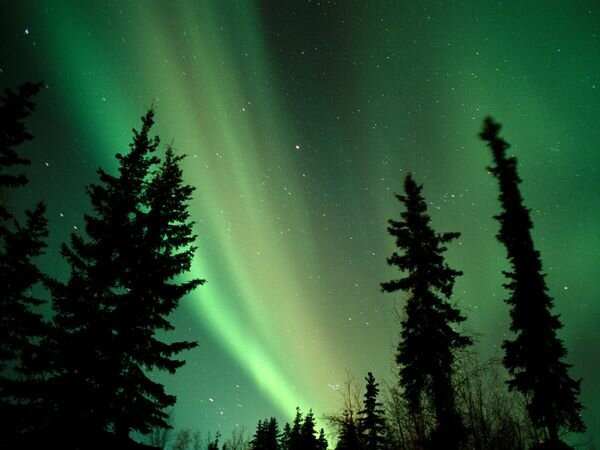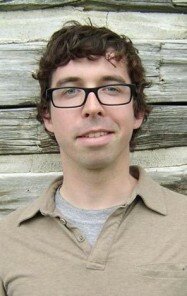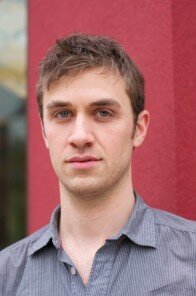The Northern Lights Inspire the Sounds of “Space Weather Listening Booth”
In November 2012, Seattle composer Nat Evans found himself in the frigid cold of Fairbanks, Alaska, mesmerized by undulating bands of glowing green light that filled the sky, reflecting off the snow below and illuminating the night. Like many before him, Evans was deeply touched by his encounter with the natural phenomenon of the aurora borealis, commonly known as the Northern Lights. “It was an absolutely mind-blowing, life changing, pseudo-spiritual event, ” he recalled.
Inspired, Evans returned home to Seattle, where he teamed up with fellow composer John Teske to develop a musical work based on his experiences in Alaska. Teske was an ideal collaborator for the project — both composers draw upon the natural world as a guiding force in their work. Birdsong, ocean tides, and the sunset figure prominently in many of their compositions, which are often site- and time-specific, requiring the piece to be performed at a specific location during a particular time of day.
After two months of composing and recording, Teske and Evans emerged with Space Weather Listening Booth, a miniature sound installation that attracted attention at January’s ONN/OF Festival on Capitol Hill. Encouraged by the positive reception, the pair reconfigured Space Weather Listening Booth as a concert piece. The work will receive its first performance on March 17 at Hollow Earth Radio‘s Magma Festival, taking over the station’s Capitol Hill studio. A second performance is scheduled for March 21 in Portland.
“With Space Weather Listening Booth, we wanted to capture the vastness but also the intimacy of experiencing the aurora borealis,” said Evans. The closet-sized installation at the ONN/OF Festival certainly highlighted the intimate aspects of the Northern Lights. One at a time, audience members were ushered into the tiny “listening booth,” where they were allowed one minute to experience the work. Inside the booth, listeners observed a lone musician improvising on their instrument while a network of speakers around the room played a collection of sounds inspired by the aurora borealis.
“Some people really loved it and wanted to stay and chat with the performers for a really long time,” said Evans, recalling the variety of audience reactions to the work’s unusual format. “Other people were really uncomfortable with the intimacy of just two people in a small room and left in the middle of the performance. But overall, the response was very positive.” The tiny sound installation intrigued many in the Seattle art community, who clamored for more. Jen Graves, visual arts writer for The Stranger, called the piece “mesmerizing.” City Arts Magazine published a glowing review, saying that the work “should be performed again somewhere else as soon as possible.”
For the new version of Space Weather Listening Booth, Teske and Evans have expanded nearly every aspect of the work, transforming the installation into a 48-minute performance piece for four unspecified instruments. (Sunday’s performance features flute, violin, cello, and theremin, an electronic instrument invented in the 1920′s.) The tiny closet has been swapped out for Hollow Earth Radio’s gallery-sized studio, which can accommodate a few dozen listeners. Evans and Teske plan to use the entirety of the space, placing speakers around the room. The performers will encircle the audience members, who are encouraged to bring blankets, pillows, and sleeping bags for “maximum enjoyment of the immersive surround-sound experience.”
Much of Space Weather Listening Booth is based on an artistic interpretation of raw scientific data. The shimmering colors of the Northern Lights arise when shifting solar winds collide with electrically- and magnetically-charged particles high in the earth’s atmosphere. A network of government observatories around the Arctic Circle constantly monitors this auroral activity, collecting geomagnetic data and solar wind measurements that are then posted on a public website. Teske and Evans tapped into this treasure trove of information, gathering data sets from the night that Evans witnessed the Northern Lights.
The two composers used the auroral data as a guideline while creating Space Weather Listening Booth‘s recorded soundtrack. The sounds on the recording all originate from percussion instruments, which were sampled and then altered using digital audio software. Teske created a collection of layered vibraphone pitches based on the geomagnetic data points, while Evans recorded sounds on a variety of gongs from around the world. These audio samples correspond to different factors that play a role in the auroral phenomenon. For example, the shimmering sound that results when a large gong is scraped with a dime represents the solar winds that constantly pummel the earth’s atmosphere.
The data sets also play an important role in the musical score. Along with more traditional notated music, the score also contains charts and graphs copied directly from the auroral data, along with directions for performance. Teske calls the work a “composed improvisation” — the performers follow a set of written musical directives and rules, but are free to interpret and choose between these guidelines as they wish.
After the two performances this month, Evans and Teske hope to bring Space Weather Listening Booth to more cities. “It’s turned out to be a pretty elegant presentation mode,” said Evans, commenting on the work’s portability. The electronic setup for the recorded soundtrack is minimal, only requiring an iPod and a set of speakers. Since the piece doesn’t specify a particular instrumentation, Evans and Teske are free to choose from a rotating cast of musicians depending on the performance locale.
Both Teske and Evans plan to continue their exploration of the natural world in their musical compositions. Inspired by the geomagnetic data sets he pored over for Space Weather Listening Booth, Teske is working on an orchestral piece based on data compiled from tide charts. Evans is planning a series of site-specific works for the summer that blend live musical performance with a variety of unusual activities, including mushroom-hunting, gardening, and a bicycle parade.
Not surprisingly, the two composers are used to receiving a wide range of reactions to their work, which often strays far from typical concert hall fare. What’s the most unusual response to Space Weather Listening Booth so far? Said Teske, “Some people asked us how we recorded the sounds from space.”



 Daily Email Digest of The SunBreak
Daily Email Digest of The SunBreak